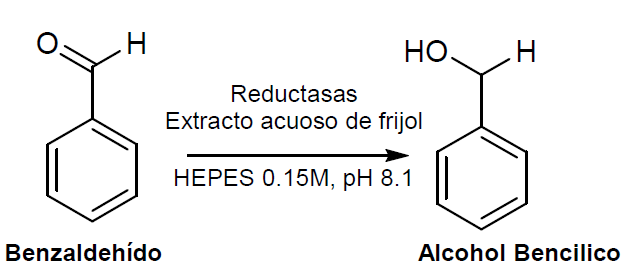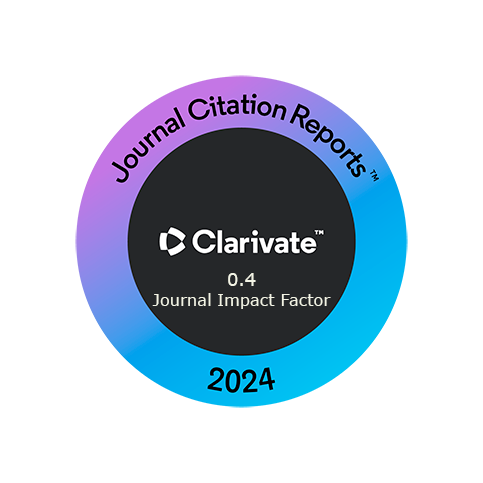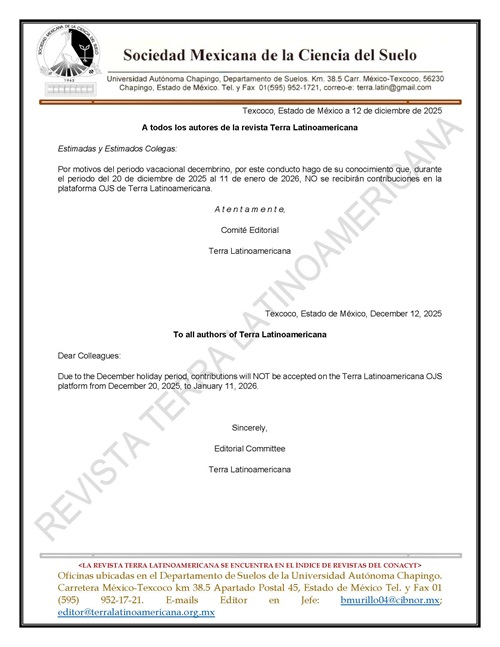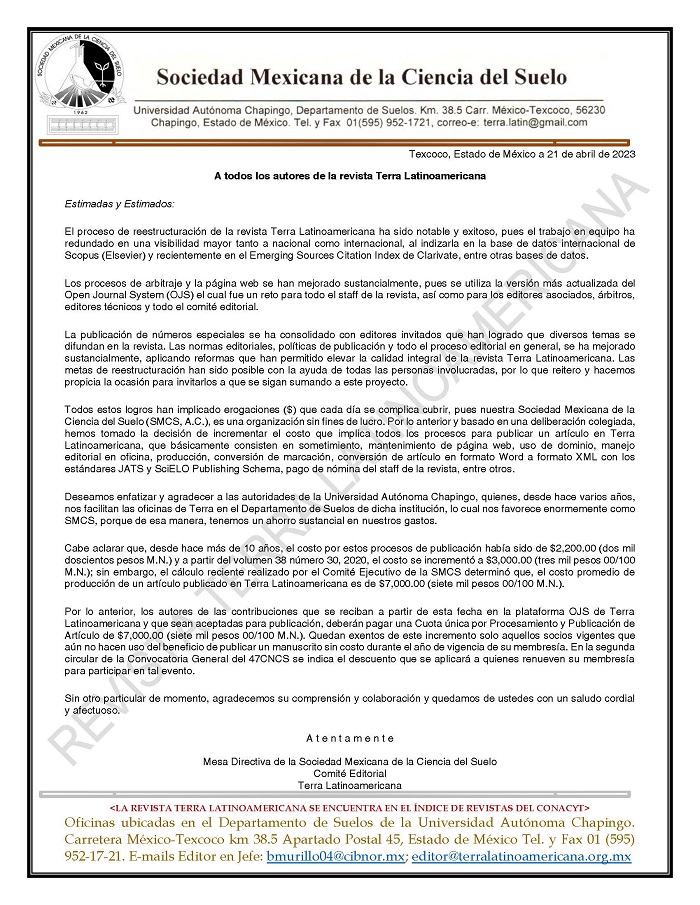Impact of Organic and Mineral Fertilization on the Reductase Activity of Three Pinto Bean Varieties
DOI:
https://doi.org/10.28940/terralatinoamericana.v43i.2213Keywords:
benzil alcohol, biocatalysis, enzymes, seaweedAbstract
Enzymes are molecules that catalyze chemical reactions; in plants, they participate in various processes related to development and defense against biotic and abiotic stress. In green chemistry, microorganisms, seeds, and plants have been studied as biocatalysts to obtain environmentally friendly products. The ef fect of organic and mineral fertilization on the seed reductase activity of three pinto bean varieties, San Rafael (SR), Libertad (Lib), and Vaquita (Vaq), was evaluated. The evaluation was carried out over three crop cycles under greenhouse conditions. Three doses of organic fertilizer (a commercial sargassum extract), three doses of mineral fertilizer, and combinations of both were considered, along with an unfertilized control. Reductase activity was measured using HPLC by quantifying the production of hydroxymethylbenzene through the reduction of benzaldehyde, with the seeds serving as the reductase source. Biocatalytic activity followed the order SR > Lib > Vaq. Enzymatic activity increased with higher doses of organic fertilization, whereas mineral fertilization had no significant ef fect. In the second crop cycle, biotic stress caused by a red spider mite infestation resulted in increased biocatalytic activity in all three varieties. Seeds obtained from crops fertilized with sargassum extract are a good source of reductases.
Downloads
Publication Facts
Reviewer profiles N/A
Author statements
- Academic society
- Terra Latinoamericana
- Publisher
- Mexican Society of Soil Science, C.A.
References
Appu, M., Ramalingam, P., Sathiyanarayanan, A., & Huang, J. (2021). An overview of plant defense-related enzymes responses to biotic stresses. Plant Gene, 27, 100302. https://doi.org/10.1016/j.plgene.2021.100302
Ashwini, T.R., Potdar, M. P., Nirmalnath, J. P., Kumar, A. B. N. & Patil, P. L. (2021). Soil enzyme activity as influenced by bt cotton genotypes and optical sensor-based nitrogen management practices. Biochemical & Cellular Archives, 21(2), 5037-5042. https://openurl.ebsco.com/contentitem/gcd:154670450?sid=ebsco:plink:crawler&id=ebsco:gcd:154670450.
Bhanushali, J., Kainthla, I., Keri, R. S., & Mallanna, N. B. (2016). Catalytic hydrogenation of benzaldehyde for selective synthesis of bencyl alcohol: A review, Chemistry Select Reviews 1, 3839 – 3853
Beyyavas, V., Ramazanoglu, E., Sakin, E., Cevheri, C. I. & Seyrek, A. (2023). Responses of some soil enzymes and cotton plant to foliar application of ferrous sulfate in a calcareous alkaline soil, Journal of Plant Nutrition, 46(14), 3421-3434. https://doi.org/10.1080/01904167.2023.2205878
Carvalho, da S. R. A., Marques, De M. B., Frota, de F. I., García, do N. P. G., Lemos, T. L. G. & Queiroz. M. F. (2018). Enzymatic chemical transformations of aldehydes, ketones, esters and alcohols using plant fragments as the only biocatalyst: Ximenia americana grains Molecular Catalysis, 445,187–194. https://doi.org/10.1016/j.mcat.2017.11.033
Demmel, G. I., Bordon, D. L., Vázquez, A. M., Decarlini, M. F., Díaz, P. M., Rossi, L. I. & Aimar, M. L. (2021). Whole seeds of Bauhinia variegata L. (Fabaceae) as an efficient biocatalyst for benzyl alcohol preparations from benzaldehydes, Biocatalysis and Biotransformation, 41(2), 93-107. https://doi.org/10.1080/10242422.2021.1956910.
Descamps, C., Quinet, M., Baijot, A., & Jacquemart, A. L. (2018). Temperature and water stress affect plant–pollinator interactions in Borago officinalis (Boraginaceae). Ecology and Evolution, 8, 3443. https://doi.org/10.1002/ece3.3914
Farouk, S., & Osman, M.A. (2011). The effect of plant defense elicitors on common bean (Phaseolus vulgaris L.) growth and yield in absence or presence of spider mite (Tetranychus urticae Koch) infestation, Journal of Stress Physiology & Biochemistry, 7(3), 5-22.
Guan, X., Yu, L., & Wang, A. (2023). Genome-wide identification and characterization of aldo-keto reductase (AKR) gene family in response to abiotic stresses in Solanum lycopersicum. International Journal of Molecular Sciences, 24(2), 1272. https://doi.org/10.3390/ijms24021272
Huo, J., Du, B., Sun, S., He, S., Zhao, N., Liu, Q. & Zhai, H. (2018). A novel aldo-keto reductase gene, IbAKR, from sweet potato confers higher tolerance to cadmium stress in tobacco, Frontiers of Agricultural Science and Engineering, 5(2), 206-2013. https://doi.org/10.15302/J-FASE-2018225
Kanayama, Y., Mizutani, R., Yaguchi, S., Hojo, A., Ikeda, H., Nishiyama, M. & Kanahama, K. (2014). Characterization of an uncharacterized aldo-keto reductase gene from peach and its role in abiotic stress tolerance, Phytochemistry, 104, 30-36. https://doi.org/10.1016/j.phytochem.2014.04.008
Kumar, D., Singh, P., Yusuf, M. A., Upadhyaya, C. P., Roy, S. D., Hohn, T. and Sarin, N. B. (2013). The Xerophyta viscosa aldose reductase (ALDRXV4) confers enhanced drought and salinity tolerance to transgenic tobacco plants by scavenging methylglyoxal and reducing the membrane damage, Molecular Biotechnology, 54(2), 292-303. https://doi.org/10.1007/s12033-012-9567-y
Oliveira, de G. P., Leite, dos S. M., Morais, de S. S., Koch, K. E., Yunes J. A., Aparicio, R., & Tyago, M. M. (2016). A comparative structural analysis reveals distinctive features of cofactor binding and substrate specificity in plant aldo-keto reductases, Biochemical and Biophysical Research Communications, 474(4), 696-701. https://doi.org/10.1016/j.bbrc.2016.05.011
Nasar, J., Wang, G. Y., Ahmad, S., Muhammad, I., Zeeshan, M., Gitari, H., Adnan, M., Fahad, S., Khalid, M. H. B., Zhou, X. B., Abdelsalam, N. R., Ahmed, G. A., & Hasan, M.E. (2022). Nitrogen fertilization coupled with iron foliar application improves the photosynthetic characteristics, photosynthetic nitrogen use efficiency, and the related enzymes of maize crops under different planting patterns. Frontiers in Plant Science, 13, 988055. https://doi.org/10.3389/fpls.2022.988055
Okino-Delgado, C. H., Prado, L. & Fleuri, F. (2018). Brazilian fruit processing, wastes as a source of lipase and other biotechnological products: a review. Biological Sciences an. Acad. Bras. Ciênc., 90 (3) https://doi.org/10.1590/0001-3765201820180095.
Rácz, D., Szőke, L., Tóth, B., Kovács, B., Horváth, É., Zagyi, P., Duzs, L., & Széles, A. (2021). Examination of the productivity and physiological responses of maize (Zea mays L.) to nitrapyrin and foliar fertilizer treatments, Plants, 10, 2426. https://doi.org/10.3390/plants10112426.
Russo, S., Luján, A. P., Fraaije, M. W., & Poelarends, G. J. (2024). Synthesis of pharmaceutically relevant arylamines enabled by a nitroreductase from Bacillus tequilensis. Chembiochem, 25(10), e202300846. https://doi.org/10.1002/cbic.202300846
Sengupta, D., Naik, D., & Reddy, A. R. (2015). Plant aldo-keto reductases (AKRs) as multi-tasking soldiers involved in diverse plant metabolic processes and stress defense: A structure-function update, Journal of Plant Physiology, 179, 40-55. https://doi.org/10.1016/j.jplph.2015.03.004
Sharma, P. K., Gurjar, R., Kumar, M., Kumar, D., & Dabaria, A. (2023). Combined effect of nitrogen and phosphorus fertilizer on the activity of the nitrate reductase enzyme in different wheat cultivars, International Journal of Environment and Climate Change, 13(1), 196-204. https://doi.org/10.9734/ijecc/2023/v13i11667
Sheldon, R. A. (2024). Green chemistry and biocatalysis: Engineering a sustainable future, Catalysis Today 431, 114571. https://doi.org/10.1016/j.cattod.2024.114571
Solís, A., Martínez, R. M., Cervantes, F., Pérez, H.I., Manjarrez, N., & Solís, M. (2019). Reduction of substituted benzaldehydes, acetophenone and 2-acetylpyridine using bean seeds as crude reductase enzymes, Biocatalysis and Biotransformation, 37(2), 152-157. https://doi.org/10.1080/10242422.2018.1510492
Solís, O. A., Martínez, P. R. M., Cervantes, D. F., Pérez, M. H. I., Solís, O. M., & Manjarrez, Á.N. (2017). Biocatalytic reduction of benzaldehyde using vegetable wastes as enzyme sources, Acta Universitaria, 27(4), 13-18. https://doi.org/10.15174/au.2017.1284
Yu J., Li Y., Qin Z., Guo S., Li Y., Miao Y., Song Ch., Chen S. (2020). Plant chloroplast stress response: Insights from thiol redox proteomics, Antioxidants & Redox Signaling. 33(1), https://doi.org/10.1089/ars.2019.7823
Zhang, W., Shao, Z. Q., Wang, Z. X., Ye, Y. F., Li, S. F. & Wang, Y. J. (2024). Advances in aldo-keto reductases immobilization for biocatalytic synthesis of chiral alcohols, International Journal of Biological Macromolecules, 274, 133264. https://doi.org/10.1016/j.ijbiomac.2024.133264

















